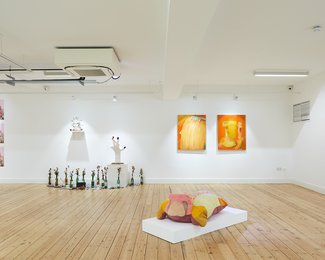
New Blood
New Blood features: Helen Clarke, Sasha Furnèe Horton, Mia Hoskins, Jaime Jover, Louise Lahive, Daniela Mendes, Katarzyna Rubach, Shannon Ryan, Lydia Stonehouse, Krystina Tyrtania and Tyler Watson.
Tue 14 Dec 2021

Could you tell us a bit more about your practice?
In my paintings, organic and geometric shapes merge with fluid textures to create dreamy, sense memories of spaces; the frame of the painting acts as container for both an imaginary and a real room. “A house that has been experienced is not an inert box. Inhabited space transcends geometrical space.” (Gaston Bachelard, The Poetics Of Space, 1957)
Oil-based inks, acrylic paint, sponge and tape combine with an evocative use of colour. The use of wood as surface gives them a premise of being salvaged, oriented to a formal rigour. The tape, placed on the edges of the painting, works as entry and exit point, extending the textured surfaces of the illusory world to the physical wall and back again. This material serves to emphasise the three-dimensional qualities of the work, as well as the geometric, two-dimensional shapes seen on the surface. As a consequence, the paintings become both image and object, collapsing distinctions between the two.
As an art student working through the pandemic please tell us about some of the challenges you faced during this time.
My work has always been very experimental and studio-based. During lockdown, by not having access to a studio space, I couldn’t work on large scale pieces and so, had to improvise and adapt my work to mediums and materials I had access to at the time, such as paper, tape and sponges. I developed a series of work on paper, which led me to the path I intend to follow today, in my paintings.
All artists were forced to adapt during the lockdown, do you think these circumstances affected your practice in any way and did you manage to find new ways of getting your work ‘out there’, such as online exhibitions?
The lockdown definitely affected my practice in the sense that I developed my digital skills more than I probably would, under normal circumstances.
I created my personal website and became more confident to share my work online (e.g., social media). Consequently, it improved my networking and opened doors in the art world. I had the opportunity to exhibit my work in virtual reality spaces.
In my opinion, the logistics of running an online exhibition, at the time, became easier than a physical one, as more people (such as communities and/or individual entities) could plan one, through online platforms, which gave me the opportunity to get my work ‘out there’.
Exhibitions such as New Blood aim to support early career artists by exposing them to new audiences, but this can only go so far. Is there anything that galleries could, or should, be doing to help develop your career further?
I believe that galleries should support graduate students more, by creating open calls for artists in their early careers, and also, by planning workshops (focusing other areas such as art curation for example) and therefore, internships/placements to expand the artist’s work experience.
Having resident artists is also a great solution, so that artists can have their one studio space to produce work, as I am strongly conviced that the opportunity to produce works of art and be inspired by a studio culture, will make the artist go further in his career.
Are there any new projects you’re working on that you’d like to tell us about?
I keep working on my paintings collection, which is always updated on my personal website. I am also developing a series of photographs that will later result in paintings on wood. I have a plan to use those photographs, not only as a starting point for paintings, but also as final pieces, incorporating masking tape.